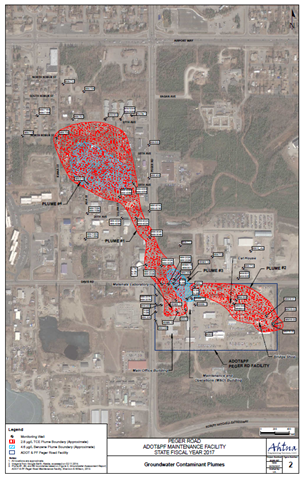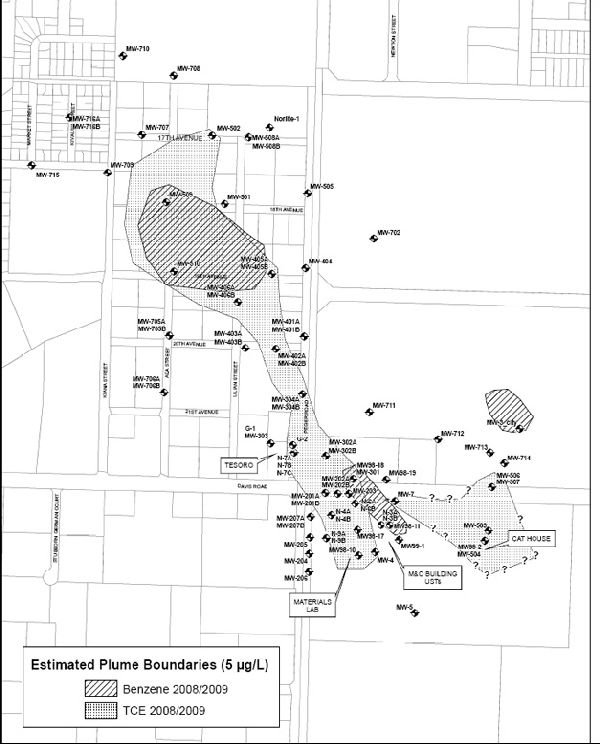Peger Road Maintenance Station
- View detailed information from the database on this site.
- Database Name: ADOT&PF Peger Road Facility
- Status: Active
- Location: Fairbanks
- Latitude: 64.825963
- Longitude: -147.769907
DEC Contaminated Sites contact: James Fish, Project Manager, 907-451-2117 (Fairbanks)
- Click on photos or maps for larger versions.
- Contacts updated: 2/16/2023
- Summary updated: 2/16/2023
Site Narrative
Description

The map (above) shows the rough boundaries of the two TCE and two benzene groundwater plumes. The areas inside all four plumes have samples from wells that exceeded DEC’s cleanup levels; the areas outside the plume boundaries had contaminant levels that were less than cleanup levels. (Map from Ahtna Engineering, 2017)
This site has soil and groundwater contaminated with chlorinated solvents and petroleum associated with maintenance activities at the Alaska Department of Transportation and Public Facilities (ADOT&PF) complex on Peger Road in Fairbanks. The contamination was first discovered in 1991 when an underground diesel storage tank was being decommissioned.
The ADOT&PF Peger Road complex includes the Maintenance and Operations building, Materials Laboratory, Technical Services, the Cat House (where Caterpillar tractors are stored), a seasonal laboratory, State equipment fleet/maintenance shop, a Bridge Shop building, equipment wash-down areas, and areas where other equipment has been stored.
Public Health and Environmental Concerns
Groundwater and some soil contaminated with chlorinated solvents and petroleum are the main threat to public health and the environment. Contaminated soil and groundwater are present on the ADOT&PF property, and contaminated groundwater travels off the property.
Four contaminated groundwater plumes have been observed at the site.
Two of the plumes contain chlorinated solvents. One of the chlorinated solvents in greatest abundance is a compound called trichloroethene, also known as TCE – a common industrial degreasing and machine cleaning agent. Other chlorinated solvents, such a trichloroethane, or TCA, have also been detected.
TCE is “reasonably anticipated to be a human carcinogen,” according to the federal Agency for Toxic Substances and Disease Registry (ATSDR), and the National Toxicology Program. It affects people’s health, even by breathing small amounts or drinking small amounts of water contaminated with TCE.
It’s unknown whether TCA causes cancer, or how breathing or swallowing it affects human health. But it affects animals that breathe or swallow it, causing damage to the liver, kidneys, blood, stomach and nervous system, according to the ATSDR.
The two other plumes, which are contaminated with petroleum, are benzene plumes. Benzene is a known carcinogen – it causes cancer in people and animals. It’s widely used in the Unites States, and is associated with fuel, such as gasoline.
It is likely PFAS is also in groundwater as the PFAS groundwater plume from the City of Fairbanks Fire Training Center has migrated through this and nearby properties.
DEC’s groundwater cleanup level – the level that contamination must be cleaned up to – for TCE is 2.8 parts per billion or micrograms per liter (µg/L), while the groundwater cleanup level for benzene is 4.6µg/L. The methods to establish groundwater cleanup levels statewide are in state regulation.
The public drinking water maximum contaminant levels (MCLs) for both TCE and benzene is 5 µg/L. MCLs are the maximum levels of certain contaminants that are permitted in public drinking water supplies, established by the U.S. Environmental Protection Agency.
Here is the current situation with contaminated groundwater plumes associated with the ADOT Peger Road facility:
- The Western TCE Plume. This is the major plume at the site. It overlaps with the Western Benzene Plume and extends off the Department of Transportation property to the northwest into commercial and residential neighborhoods.
- The Eastern TCE Plume. This plume appears to extend off the Department of Transportation property in both a northerly and easterly direction.
- The Western Benzene Plume. This plume, as shown on the map of the plumes (right), is the only plume of the four based on 2009 sampling results. When the same wells were sampled in 2012, benzene was still in the wells, but the amount of benzene was below DEC’s 5 parts per billion groundwater cleanup level.
- The Eastern Benzene Plume. This plume also appears to be diminishing in size, similar to the Western Benzene Plume.
What is vapor intrusion?
Many chemicals off fumes – these chemicals are called “volatile.” When released into the soil or groundwater, a certain amount of the chemical vaporizes into the small air spaces within the soil. The larger the chemical spill and the more volatile the chemical, the more chemical vapors move into the air spaces. This air is called soil gas. If the air pressure inside the building is lower than in the soil, or if the amount of chemicals in the soil gas is high, the vapors move, or intrude, into any open space, such as cracks in foundations, crawl spaces and basements. People in buildings can sometimes smell a chemical, but often the chemicals are odorless or too faint to smell.

The above overhead view shows the Alaska Department of Transportation and Public Facilities complex, which is at the southeast corner of Peger and Davis roads in Fairbanks. (Map from Shannon & Wilson, Inc.)
Current Status
Since the 2012 site investigations, additional private well monitoring and offsite evaluation of vapor intrusion risk was conducted in 2014-2015. An additional source/release location of solvent contamination in soil and groundwater was also delineated in 2016 near the eastern property boundary. Vapor intrusion risks were evaluated for buildings on the ADOT Peger Road Facility during 2017 and 2018, and again during 2019 and 2020. Results from these recent efforts are summarized below:
- The Western TCE Plume (again, the major plume) extending from the Department of Transportation complex northerly to 17th Avenue and westerly toward Kiana Street appears to be stable and decreasing in concentration. The Western benzene plume is currently below regulatory cleanup levels. DEC will continue to monitor these plumes as they slowly attenuate.
- The Eastern Benzene Plume, which also commingles with the Western TCE Plume, spans across Davis Road. DEC will also continue to monitor this plume both on and off the facility property.
- Additional sources of TCE were discovered during 2010-12 at the eastern property boundary of the ADOT Peger Road facility, and that contamination is labeled as the Eastern TCE Plume. This source was further defined in 2016, where results identified solvent contamination in both soil and groundwater contamination that likely extends offsite to the east.
- Offsite residential groundwater wells (either drinking water or irrigation wells) are affected by the Western TCE and Benzene Plumes, but those wells have contaminant concentrations that are relatively low and below the public drinking water MCLs of 5 parts per billion. These wells were last sampled in 2014, and were again below public drinking water levels of concern. Many residences have since been connected to municipal piped water as part of the response actions by the City of Fairbanks to per-and polyfluoroalkyl substance contamination in groundwater, associated with the Fairbanks Regional Fire Training Center (near the Mitchell Expressway). The only remaining residential well was sampled in 2020 for solvents associated with the ADOT Peger Road Facility –results were non-detect or below levels of concern. PFAS, presumable from the City of Fairbanks Fire Training Center mentioned above, was present in this well. DEC understands this well is not used for drinking water, and will continue to monitor this well.
- Soil gas was collected from various locations on the ADOT Peger Road complex in 2017. Elevated levels of solvents in soil vapors led to evaluating the Main Office building and the Bridge Shop building for Vapor intrusion risks in 2017 and 2018. Results indicate that vapor intrusion is nor occurring at the Main Office building, but was occurring at the Bridge Shop (located near the eastern TCE source area). Mitigation efforts were implemented temporarily at the Bridge Shop with carbon-based air filters. Additional evaluation occurred during 2019 and 2020, and although contaminants (PCE and TCE) were detected in indoor air, they were below DEC’s target levels. Benzene was detected in indoor air at the Bridge Shopp, and is attributed to use of chemicals common to industrial equipment maintenance. Additional evaluation of vapor intrusion is anticipated for 2023-2024.
- ADOT recently installed a sub-slab depressurization system, or SSD, below the building the newly constructed Traffic Operation Center, a new building addition to the Maintenance and Operations (M&O) building in 2017. A SSD system creates a vacuum-induced negative pressure beneath a building’s foundation slab to prevent vapor intrusion – a situation where vapors from contamination in groundwater and soil beneath the building enter the building, making the indoor air unhealthy. A similar system was installed in the Materials Laboratory in 2004. Results of indoor air samples collected in 2017-18, and again during 2019 and 2020 from Traffic Operations Center and M&O building indicate the SSD system is effective at mitigating vapor intrusion.
What's Next
Additional assessment vapor intrusion at the Bride Shop is required to understand what is causing vapor intrusion and whether additional mitigation is warranted. Periodic monitoring of indoor air quality at the Traffic Operations Center and the Materials Laboratory will also continue.
DEC will continue to monitor groundwater quality throughout the plumes, periodically evaluate the monitored natural attenuation approach as a groundwater cleanup strategy, and continue to monitor the vapor intrusion pathway where contaminant exposure risks may be present.
DEC will also continue to coordinate investigative efforts with the various responsible parties of other contaminated sites in the area to determine if they are contributing to the area-wide groundwater contamination.

The estimated boundaries of the plumes are shown (above) as they were in June 2009. (Download in PDF) (Map from Shannon & Wilson)
More Information
Historical background on the site, as well as more information about the contaminants, can be found in the following fact sheets and links:
- Fact Sheet for 2003 (PDF 23K)
- Fact Sheet for 2004 (PDF 91K)
- Fact Sheet for 2006 (PDF 32M)
- Site summary on website as of June 2009 (PDF 303K)
- US Geological Survey website on natural attenuation of chlorinated solvents at this site
- Fact sheet on trichloroethene, or TCE (also spelled trichloroethylene) from the federal Agency for Toxic Substances and Disease Registry, July 2003
- Fact sheet on benzene from the federal Agency for Toxic Substances and Disease Registry, August 2007
- Alaska Department of Environmental Conservation fact sheet, Additional Information about Exposure to TCE, January 8, 2014 (PDF 94K)
- DEC fact sheet, Contaminants in Alaska
- DEC fact sheet, Introduction to Groundwater
- DEC fact sheet, Human Health Risk Assessment
- DEC fact sheet, Contaminant Concentrations
- DEC fact sheet, Environmental Cleanup Methods (PDF 277K)
- Agency for Toxic Substances and Disease Registry home page
- National Toxicology Program home page

